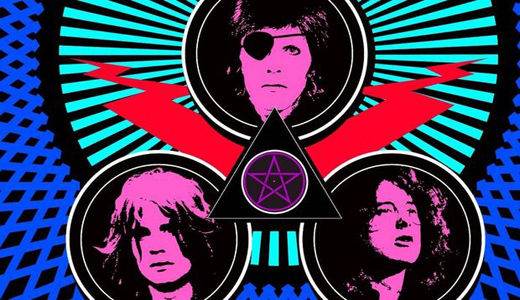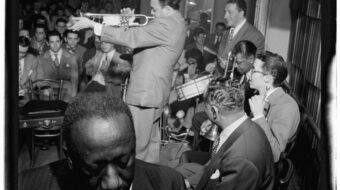
Once again, it’s Halloween. And while the pagan origins of the holiday have been blurred through a lense of commercialism and largely forgotten, there are some to whom the occult and folklore are still subjects worthy of research and even practice. Perhaps nowhere in modern culture was its presence more prevalent than throughout the history of heavy music. In the book Season of the Witch: How the Occult Saved Rock and Roll, author Peter Bebergal traces its lineage back to its varied mystical roots.
The seeds of blues music
Bebergal takes readers back to Haitian mythology, wherein the seeds of blues music lay. “If you want to learn to play guitar, find a crossroads and wait there at midnight,” writes Bebergal. “If you are patient, ‘a large black man’ will emerge from the gloom. It could be Papa Legba, a Haitian deity whose strange origins lie in the religion known as vodou. It could also be Eshu, a West African Yoruba god who is a guardian of pathways.”
Or it could be a demon; that’s the old story of Delta blues singer Robert Johnson, who sold his soul at a crossroads for his talent, or so the legend went. And the rumor was, a good number of years after this arrangement was made, a hellhound would come to collect, and drag you to Hell. Note some of Johnson’s song titles, like “Crossroad Blues” and “Hellhound On My Trail.” It was a later version of the Legba/Eshu tale that was expounded upon; these sorts of things happened when African Americans came over as slaves to the U.S., and their religions clashed – albeit, to some extent, coalesced – with Christianity.
The author remarked that even in these pre-rock days, when owning slaves was the norm, the Catholic Church had its scapegoats. Before rock icons, it was African Americans, says Bebergal, who bore the brunt of Christianity’s harsh disapproval. Yet they held on to many of their customs and much of their lore, even amidst the burdens of racism and slavery. “For the Christian South, distrustful of anything that did not conform to the church and suspicious of secular music in general, the blues was a perfect storm, a tempest challenging the idea that an American black identity had to be bound up in the church.”
Transmitter for a new spiritual truth
Speaking as an occult enthusiast, as well as a classic rock and metal fan, I prepared myself for the possibility that this book would be another clichéd assumption that attention-seeking devilry served as the sole motivating force behind all “occult rock” bands. Fortunately, Bebergal doesn’t go that route. He provides a true examination of the scope of occult beliefs, initially documenting its LSD-laden, New Age/hippie-centric presence in music. “It was in England,” asserts Bebergal, “where bands found a formula for injecting a dose of adrenaline into the syrupy pop that had become the staple of radio play.” With bands like “the Beatles, the Who, and others of the British Invasion … it was [all about] the LSD experience, held aloft by Eastern mysticism, that would utterly transfigure rock’s sound and performance, and its ability to convince fans it was a transmitter for a new spiritual truth.”
The Beatles were meeting with Maharishi Mahesh Yogi, practicing transcendental meditation, and England and the U.S. were by this time “infused with a fascination about the occult, one dependent on the idea of teachers from the East to give it form and function.”
Part of what can be gleaned from this book is that, whether or not we, as materialists, believe that “heightened spiritual awareness” or “enlightenment” can actuate any sort of progressive societal change, what’s worth noting is that the cultural ramifications effected by these ideas can. One such example is the multiculturalism established by this New Age expansion of rock and roll, as when the Beatles began to incorporate the sitar into their songs, unwittingly offering parts of traditional Indian music to the U.S. mainstream palate – a musical communion that transfigured a previously inaccessible sound into something with which a listener from the states could begin to identify.
Bebergal does, of course, transition the reader to the period when things began to take an aesthetically darker turn; the drug-fuelled mystic lyricism and the hippie-peace-Woodstock era was drawing to a close, and filling the void left by it was a collection of bands that wanted to dabble, at least thematically, in the more controversial and “black magickal” portion of occultism. These artists were cut more from the cloth of Aleister Crowley than Madame Blavatsky.
Indefinable by nature?
For the Rolling Stones, however, the influence of the occult was used primarily to shroud the band in a veneer of darkness and mystery. Berbegal wrote that he believed occultism to be “indefinable; a tabula rasa that becomes a projection of whatever fears or desires that culture needs, and do not fit within a mainstream context,” though “the irony of the Stones in this narrative is that, except for Mick Jagger’s almost faddish interest in the occult … the band had no abiding spiritual motivation beyond that of making music.”
Next came Led Zeppelin, and while they too were a rock band, they sowed the seeds of what would soon be known as ‘heavy metal.’ Accordingly, they upped the ante in terms of occult presence, but even there, it was largely fantasy-based – more Tolkien than Zoroaster. The height of their popularity came at a time when “book publishers such as Ace and Ballantine were putting out cheap paperbacks of old sword-and-sorcery stories.” In other words, fantasy-oriented mysticism was in vogue, and Led Zeppelin wanted to embody that when and where they needed.
Then came Ozzy Osbourne; arguably, Black Sabbath was the first true heavy metal band, though Bebergal astutely noted that rock band Coven (who had heavy themes of witchcraft) were the first to ‘throw up the horns’ – “the hand sign with up-raised index finger and pinkie that would become the staple gesture of metal fans.” Nevertheless, Ozzy and Sabbath ranked even higher on the occult scale: “The covers to his first two solo records, Blizzard of Oz and Diary of a Madman, are both suggestive of Osbourne practicing some kind of wicked magic. Fans loved it.”
But it was Marilyn Manson who truly took things seriously and helped pave the way for a new era of dark identity for music fans during the 90s. Despite his image-centric “shock” reputation, which was a decade-long thorn in the side of Christian conservatives, he practiced what he preached. Manson remains a member of the Church of Satan and his most iconic album, Antichrist Superstar, is laced with complex occult themes to such an extent that it is still being examined and analyzed by college professors and philosophers today.
Ritualistic roots disregarded
One disappointment for me was a lack of emphasis on black metal, and I say this not out of favoritism, but because it is the single type of modern music most closely associated with the occult today, and yet it got only a passing mention. It was great, of course, that the author at least cited bands like drone metal artist Sunn O))) (whose concerts are often called long, somber ceremonies of sonic experimentation), and U.S. proto-black metaller King Diamond. And yet, the well-known ritualistic roots of Norwegian and Swedish black metal were disregarded and, I feel, deserved coverage.
There seems to be a decent balance in the book when it comes to covering both the musical and magickal aspects of its source material. When noting the influence of a particular occult belief system on a band, Bebergal goes into detail, and name drops practitioners like Crowley, Blavatsky, John Dee, filmmaker Kenneth Anger, and Church of Satan founder Anton LaVey. He also references other important books that touch on interrelated subjects, such as black metal handbook Lords of Chaos and art-magick analysis Surrealism of the Occult.
Bebergal does, however, make a factual error. He credits the origins of Baphomet, a demon famously drawn in 1856 by occultist Eliphas Levi (who is surprisingly not mentioned in the book), and currently used as the figurehead of the Church of Satan, to the Freemasons. Actually, the character was likely established by the Knights Templar, and its name is believed to have been derived from that of Egyptian ram deity Banebdjedet.
Fuel for cultural evolution
Overall, the book is generally well-written, because its analyses are dedicated, unbiased, and free of embellishment. Interestingly, it shows how occultism served, at times, as its own kind of fuel for cultural evolution and development. This made me think of the Beatles-inspired musical film Across the Universe, in which, at the height of Vietnam War protests, an artistic painter was told that by refusing to take part in these demonstrations, he was removing himself from important political involvement and doing nothing; in truth, many artists and musicians of that time were trying to change the world in their own way, by inspiring listeners to look inward first. Season of the Witch related this to the reader – that people’s very lives were being changed by the occult-charged lyrics and sounds of the time.
This notion seemed curious at first, but it made sense as I remembered a piece of art that currently hangs on the wall of the People’s World office, featuring a quote by Bertolt Brecht: “Art is not a mirror held up to reality, but a hammer with which to shape it.” And there it is; through the passing down of various folklore and mythos, each rock and roll icon has picked up that hammer and chiseled new features into the myriad statues of old – those pagan figures who continue to inspire artists today. And while others were doing their best to change reality for the better on the surface, these dabblers in the occult were working down below, in the proverbial belly of the beast, outside the purview of conformist convention, transforming pop culture and, by proxy, the world we live in. Believer or not, if that isn’t magic, I don’t know what is.
Season of the Witch: How the Occult Saved Rock and Roll
Peter Bebergal
Penguin Random House publishing, 2014, 252 pages
Photo: Image taken from book cover. WNYC.org












Comments